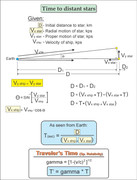Hello.
I'm writing a story about a manned spacecraft capable of leaving the solar system. In my story, the vessel must complete a trial run to Neptune, then be sent on a one way trip to colonize Ross 128B; so I have questions about both trips. I've chosen a Photonic laser thruster system as the means of travel, and I will need the vessel to reach .9 light speed. I realize that the math for this really does not work out, but I've decided to postulate that future science will overcome the current impossibilities and modify the system that Young Bae has researched to make the trip feasable.
I have some questions for the experts here and would really appreciate knowledge as well as opinions you may wish to share. My goal is not perfection, but rather to craft a story that won't sound completly silly to someone who has a broad knowledge of such things.
I hope I'm not dumping too much into one thread, but certianally don't want 20 threads cluttering up the place; so several questions follow:
1. What would be the fastest that a spacecraft could accelerate/decelerate without turning humans into Jello?
2. I've read that a trip to Neptune at .9 would take just over 4 hours to reach Neptune. But how long would it take factoring in Acceleration and Deceleration
(A + D)? I would have the same question for Ross128B, which is just over 11 light years from earth.
3. Assuming the trip to Neptune was planned to reach her at her closest point to earth, would it matter much if the return trip were delayed? Let's say that the vessel planned a 3 day loiter and the time was increased a day?
4. The vessel must have the ability to see and record data (of course). Would it be correct to use the term 'Scanners', or maybe 'Sensors'?
5. I'm sure the math to send a vessel to Ross 128 would be formidable. Would it be necessary to allow the spacecraft to alter course during the trip?
Thank you very much for any input.
I'm writing a story about a manned spacecraft capable of leaving the solar system. In my story, the vessel must complete a trial run to Neptune, then be sent on a one way trip to colonize Ross 128B; so I have questions about both trips. I've chosen a Photonic laser thruster system as the means of travel, and I will need the vessel to reach .9 light speed. I realize that the math for this really does not work out, but I've decided to postulate that future science will overcome the current impossibilities and modify the system that Young Bae has researched to make the trip feasable.
I have some questions for the experts here and would really appreciate knowledge as well as opinions you may wish to share. My goal is not perfection, but rather to craft a story that won't sound completly silly to someone who has a broad knowledge of such things.
I hope I'm not dumping too much into one thread, but certianally don't want 20 threads cluttering up the place; so several questions follow:
1. What would be the fastest that a spacecraft could accelerate/decelerate without turning humans into Jello?
2. I've read that a trip to Neptune at .9 would take just over 4 hours to reach Neptune. But how long would it take factoring in Acceleration and Deceleration
(A + D)? I would have the same question for Ross128B, which is just over 11 light years from earth.
3. Assuming the trip to Neptune was planned to reach her at her closest point to earth, would it matter much if the return trip were delayed? Let's say that the vessel planned a 3 day loiter and the time was increased a day?
4. The vessel must have the ability to see and record data (of course). Would it be correct to use the term 'Scanners', or maybe 'Sensors'?
5. I'm sure the math to send a vessel to Ross 128 would be formidable. Would it be necessary to allow the spacecraft to alter course during the trip?
Thank you very much for any input.



